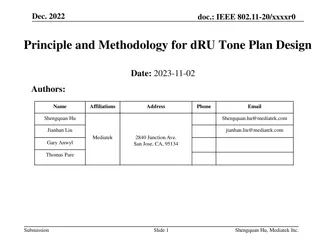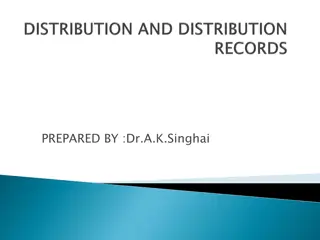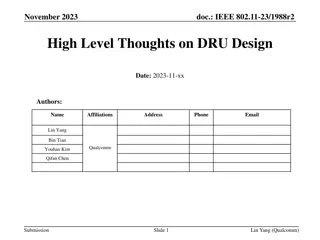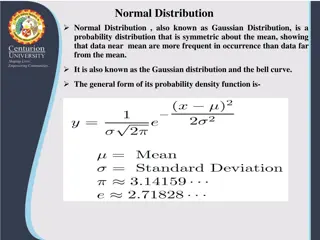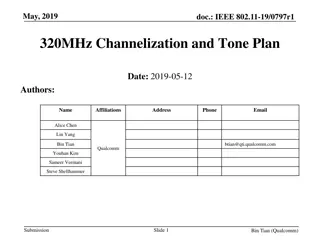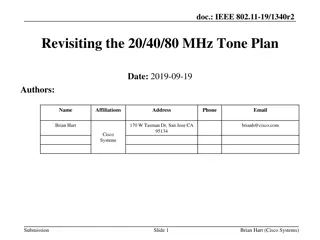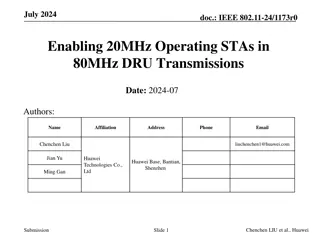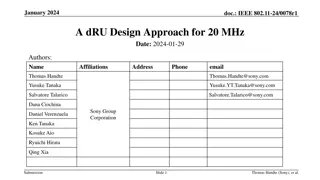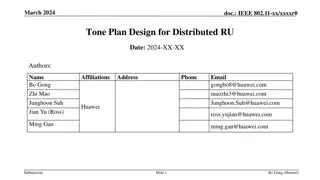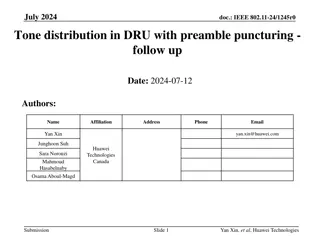
Tone Distribution in DRUs for IEEE 802.11-24 Standard
Exploring tone distribution in Distributed Resource Units (DRUs) for IEEE 802.11-24 standard, this document outlines design criteria and considerations for achieving uniform or near-uniform tone distribution to enhance performance in wireless communication systems. The relation between tone distribution in DRUs and interleaving techniques is also discussed, shedding light on prime interleaving for efficient symbol spreading. Additionally, insights on relative prime interleaving and its modifications are presented for optimizing symbol mapping in communication systems.
Download Presentation

Please find below an Image/Link to download the presentation.
The content on the website is provided AS IS for your information and personal use only. It may not be sold, licensed, or shared on other websites without obtaining consent from the author. If you encounter any issues during the download, it is possible that the publisher has removed the file from their server.
You are allowed to download the files provided on this website for personal or commercial use, subject to the condition that they are used lawfully. All files are the property of their respective owners.
The content on the website is provided AS IS for your information and personal use only. It may not be sold, licensed, or shared on other websites without obtaining consent from the author.
E N D
Presentation Transcript
May 2024 doc.: IEEE 802.11-24/0814r0 Tone distribution in DRUs Date: 2024-05-10 Authors: Name Affiliation Address Phone Email Yan Xin yan.xin@huawei.com Sara Norouzi sara.norouzi1@huawei.com Huawei Technologies Canada Junghoon Suh Junghoon.Suh@huawei.com Osama Aboul-Magd Osama.AboulMagd@huawei.com Submission Slide 1 Yan Xin, et. al, Huawei Technologies
May 2024 doc.: IEEE 802.11-24/0814r0 Introduction DRU tone plan designs with consideration of uniform or near-uniform tone distribution for 802.11bn have been proposed [1], which are based on the design criteria for distributed tones in DRU as considered in [2]. The design criteria [2] on the distributed data and pilot tones are summarized as follows: - to maximize per tone transmit power by minimizing the number of tones per MHz (i.e.,by increasing a tone separation in a RU) - to have a one-to-one mapping between an RRU and a DRU to simplify signaling, to preserve existing RRU hierarchical structure, and to reuse the existing RU Allocation - to keep the RU sizes in 802.11be unchanged - to distribute tones in a DRU as uniformly as possible for ease and/or balance of smoothing, phase tracking, and implementation etc. These criteria may also be applied to the tone distribution in multiple DRUs (M-DRU) where more than one DRU is allocated to a single STA and/or the tone distribution in DRUs in an OFDMA PPDU with puncturing. Submission Slide 2 Yan Xin, et. al, Huawei Technologies
May 2024 doc.: IEEE 802.11-24/0814r0 Relation between tone distribution in DRUs and interleaving In general, tone distribution from an RRU to a DRU for a STA in an OFDMA PPDU can be considered as an one-to-one mapping between a set of data and pilot tones in an RRU to another set of the same data and pilot tones in a corresponding DRU with different indices. The indices of Guard tones, DC tones and Null tones (if applicable) in an OFDMA PPDU are predefined and fixed. Interleaving technique has been widely used in communication systems. A practical interleaver permutes a sequence of symbols in an one-to-one mapping manner. Prime interleaver is a type of proven practical interleaver with good symbol spreading properties and ease of implementation, which was adopted and has been widely used as the internal interleaver in turbo encoder/decoder in 3GPP 3G and 4G cellular systems [3, 4]. With a prime interleaver, the symbol index mapping before and after interleaving can be generated on-the-fly . A symbol index mapping table in the interleaving is not necessary to be pre-stored. This feature may have a benefit to the implementation. Submission Slide 3 Yan Xin, et. al, Huawei Technologies
May 2024 doc.: IEEE 802.11-24/0814r0 Relative prime interleaving In relative prime interleaving [5], assuming that an original sequence is composed of N symbols with indices n, {??} (? = 0, ,? 1), the neighboring symbols in the original sequence are spread out over GF (N) with a desired symbol separation in the interleaved sequence {??(?) 0, ,? 1). The relationship between the interleaver input index n and the interleaver output index ? ? is shown as follows: where p is an integer which is a relative prime with N. Therefore, the interleaved sequence of N symbols, {?? Example: the mapping between the input indices and the output of indices of a relative prime interleaver is shown below given that p = 11 and N = 26 } (?(?) = ?(?) = ? ? mod ? = ??, ? = 0, ,? 1 } (? = 0, ,? 1), follows: . ??(?) Relative prime interleaving can be slightly modified, e.g., with a simple shortening technique (see Appendix) when ? and N are not relatively prime. The parameters of p and N in relative prime interleaving can be related to the parameters of tone separation and the (maximum) total number of data/pilot tones in DRUs in an OFDMA UHR PPDU, respectively. Submission Slide 4 Yan Xin, et. al, Huawei Technologies
May 2024 doc.: IEEE 802.11-24/0814r0 Methodology of tone distribution in DRUs by use of relative prime interleaving in which the ??data/pilot subcarriers in the jth RRU have an one-to-one mapping with the interleaved (distributed) ??subcarriers in the jth DRU through interleaving. Submission Slide 5 Yan Xin, et. al, Huawei Technologies
May 2024 doc.: IEEE 802.11-24/0814r0 Tone distribution in DRUs in a 20 MHz UHR PPDU Nine 26-tone DRUs each with uniform tone separation of 9 in a 20 MHz UHR PPDU Parameters N and p in the relative prime interleaving are related to the tone distribution in DRUs: o - Length of intermediate RRU sequence: N = 234 (=9*26) - p = 9 Before interleaving - indices of intermediate RRU tone sequence: [0:233] After interleaving - the corresponding indices of intermediate DRU tone sequence: [0:9:225, 1:9:226, 2:9:227, 3:9:228, 4:9:229, 5:9:230, 6:9:231, 7:9:232, 8:9:233] Partitioning the intermediate RRU tone sequence into RRUs yields a one-to-one mapping between a specific RRU and the corresponding DRU. Note that subcarriers in each DRU are uniformly distributed. o o o Submission Slide 6 Yan Xin, et. al, Huawei Technologies
May 2024 doc.: IEEE 802.11-24/0814r0 Tone distribution in DRUs in a 20 MHz UHR PPDU Multiplexed multiple 26-tone and 52-tone DRUs with uniform tone separation of 4 in a 20 MHz UHR PPDU Parameters N and p in the relative prime interleaving are related to the tone distribution in DRUs: o - Length of intermediate RRU sequence: N = 234 (e.g., =4*52+26) - p = 4 Before interleaving - indices of intermediate RRU tone sequence: [0:233] After interleaving - the corresponding indices of intermediate DRU tone sequence: [0:4:232, 3:4:231, 2:4:230, 1:4:233] Partitioning the intermediate RRU tone sequence into RRUs yields a one-to-one mapping between a specific RRU and the corresponding DRU. An example of tone distribution for three 52-tone and three 26-tone DRUs with tone separation of 4 is shown below. Note that the subcarriers in DRU of equal or different DRU sizes are uniformly distributed. o o o Submission Slide 7 Yan Xin, et. al, Huawei Technologies
May 2024 doc.: IEEE 802.11-24/0814r0 Tone distribution in DRUs in a 20 MHz UHR PPDU Multiplexed two 106-tone and/or one 26-tone DRUs with uniform tone separation of 2 in a 20 MHz UHR PPDU Parameters N and p in the relative prime interleaving are related to the tone distribution in DRUs: o - Length of intermediate RRU sequence: N = 238 (=2*106+26) - p = 2 Before interleaving - indices of intermediate RRU tone sequence: [0:237] After interleaving - the corresponding indices of intermediate DRU tone sequence: [0:2:236, 1:2:237] Partitioning the intermediate RRU tone sequence into RRUs yields a one-to-one mapping between a specific RRU and the corresponding DRU. An example of tone distribution for two 106-tone DRUs and one 26-tone DRUs with tone separation of 2 is shown below. Note that the subcarriers in DRUs equal or different DRU sizes are uniformly distributed. o o o Submission Slide 8 Yan Xin, et. al, Huawei Technologies
May 2024 doc.: IEEE 802.11-24/0814r0 Tone distribution in DRUs in a 20 MHz UHR PPDU Multiplexed one 106-tone and multiple 26- and 52-tone DRUs with uniform tone separation of 2 in a 20 MHz UHR PPDU Parameters N and p in the relative prime interleaving are related to the tone distribution in DRUs: o - Length of intermediate RRU sequence: N = 236 (e.g., =106+2*52+26) - p = 2 Before interleaving - indices of intermediate RRU tone sequence: [0:235] After interleaving - the corresponding indices of intermediate DRU tone sequence: [0:2:234, 1:2:235] Partitioning the modified intermediate RRU tone sequence into RRUs yields a one-to-one mapping between a specific RRU and the corresponding DRU. An example of tone distribution for a combination of one 106-tone, two 52-tone and one 26-tone DRUs with tone separation of 2 is shown below. Note that the subcarriers in DRUs equal or different DRU sizes are uniformly distributed. o o o Submission Slide 9 Yan Xin, et. al, Huawei Technologies
May 2024 doc.: IEEE 802.11-24/0814r0 Tone distribution in M-DRUs In EHT, small size RUs can only be combined with small size RUs to form small size MRUs. A similar rule may also be applied to M-DRUs in UHR, i.e., for small size M- DRUs, 52+26-tone and 106+26-tone M-DRUs are considered. Multiplexed 52+26-tone M-DRU with 26- and 52-tone DRUs with uniform tone separation of 3 in a 20 MHz UHR PPDU o Parameters N and p in the relative prime interleaving are related to the tone distribution in DRUs: - Length of intermediate RRU sequence: N = 234; p = 3 Before interleaving - indices of intermediate RRU tone sequence: [0:233] After interleaving - the corresponding indices of intermediate DRU tone sequence: [0:3:231, 1:3:232, 2:3:233] Partitioning the intermediate RRU tone sequence into MRU(s) and RRU(s) yields a one-to-one mapping between a specific MRU or RRU and the corresponding M-DRU or DRU. An example of tone distribution for two 52+26-tone M-DRUs, one 52-tone DRU and one 26-tone DRU with tone separation of 3 is shown below. Note that the subcarriers in M-DRUs and DRUs are uniformly distributed. For a larger tone separation in M-DRU, a wider DRU BW is needed. o o o Submission Slide 10 Yan Xin, et. al, Huawei Technologies
May 2024 doc.: IEEE 802.11-24/0814r0 Tone distribution in M-DRUs Multiplexed a 106+26-tone M-DRU and a 106-tone DRU with uniform or near uniform tone separation of 2 in a 20 MHz UHR PPDU As shown above for tone distribution of two 106-tone and/or one 26-tone DRUs with uniform tone separation of 2 in a 20 MHz UHR PPDU Parameters N and p in the relative prime interleaving are related to the tone distribution in DRUs: - Length of intermediate RRU sequence: N = 238 (=2*106+26); p = 2 Before interleaving - indices of intermediate RRU tone sequence: [0:237] After interleaving - the corresponding indices of intermediate DRU tone sequence: [0:2:236, 1:2:237] Partitioning the intermediate RRU tone sequence into one 106+26-tone MRU and one 106-tone RRU yields a one-to-one mapping between a specific MRU or RRU and the corresponding M-DRU or DRU. An example of tone distribution for one 106+26-tone DRU and one 106-tone DRU with desired tone separation of 2 is shown below. Note that in the M-DRU, 105 tones in the 106+26-tone DRU have tone separation of 2 and 27 tones in this M-DRU have tone separation of 1. The tones in the DRU are uniformly distributed with tone separation of 2. o o o o Submission Slide 11 Yan Xin, et. al, Huawei Technologies
May 2024 doc.: IEEE 802.11-24/0814r0 Tone distribution in DRU in a PPDU with preamble puncturing In a PPDU with a punctured or unassigned subchannel, only a part of operating channel is available to be used for transmissions of RRU. Similarly, this should also be considered for transmissions of DRU in a TB PPDU with preamble puncturing. Tone distribution in DRU in a PPDU with preamble puncturing by using relative prime interleaving Submission Slide 12 Yan Xin, et. al, Huawei Technologies
May 2024 doc.: IEEE 802.11-24/0814r0 Tone distribution in DRU in a PPDU with preamble puncturing The following example shows tone distribution for three 242-tone DRUs by using relative prime interleaving in an 80 MHz TB PPDU with the second 20 MHz subchannel being punctured. Submission Slide 13 Yan Xin, et. al, Huawei Technologies
May 2024 doc.: IEEE 802.11-24/0814r0 Tone distribution in DRUs in a larger BW UHR PPDU Tone distribution in DRUs and M-DRUs in a 40, 80, 160 and 320 MHz UHR PPDU can be extended from the tone distribution in DRUs and M-DRUs based on the design methodology described in this contribution. Submission Slide 14 Yan Xin, et. al, Huawei Technologies
May 2024 doc.: IEEE 802.11-24/0814r0 Summary This contribution proposes a systematic and generic design method by using the interleaving technique for uniform or near-uniform tone distribution in DRUs and M- DRUs of equal and different DRU sizes within a UHR PPDU. It is flexible for design of DRUs and M-DRUs in UHR PPDUs with various BWs and with preamble puncturing. The existing RU allocation tables specified in 802.11be remain unchanged and can be reused by this interleaving method. With this interleaving method, mappings between the indices of RRUs and the indices of DRUs/M-DRUs can be generated on-the-fly . A mapping table in the interleaving is not necessary to be pre-stored. This may have benefits to implementation. Submission Slide 15 Yan Xin, et. al, Huawei Technologies
May 2024 doc.: IEEE 802.11-24/0814r0 Appendix Relative prime interleaving with shortening In relative prime interleaving, assume that a symbol sequence before interleaving is {??} (? = 0, ,? 1) and the symbol sequence after interleaving is {??(?) ??(?) = ??. Relative prime interleaving fails when the parameters of sequence length N and the integer p are not relatively prime. Relative prime interleaving can be slightly modified by shortening sequence {??}. - If p and N-1 are not relatively prime, but p and N-1 are relatively prime, shortening last symbol in {??}, i.e., ?? 1, yields a symbol sequence before interleaving {??} (? = 0, ,? 2); - Applying relative prime interleaving using parameters p and N-1 to {??} results in the interleaved symbol sequence {??(?) } (?(?) = 0, ,? 2); - Padding ?? 1 = ?? 1to the interleaved sequence {??(?) complete interleaved symbol sequence {??(?) } (?(?) = 0, ,? 1) where } (?(?) = 0, ,? 2) generates the } (?(?) = 0, ,? 1). Submission Slide 16 Yan Xin, et. al, Huawei Technologies
May 2020 doc.: IEEE 802.11-24/0814r0 Reference [1] 802.11-24/0468r1, DRU tone plan for 11bn, March 2024. [2] 802.11-23/2021r1, Principle and methodology for DRU tone plan design, January 2024. [3] 3GPP TS 25.212, Multiplexing and channel coding (FDD) [4] 3GPP TS 36.212, Evolved Universal Terrestrial Radio Access (E-UTRA); Multiplexing and channel coding [5] S. Crozier and P. Guinand, High-performance low-memory interleaver banks for Turbo- codes, VTC 2001, pp. 2394-2398 Submission Slide 17 Yan Xin, et. al, Huawei Technologies
May 2024 doc.: IEEE 802.11-24/0814r0 SP1 Do you agree to consider to apply the interleaving technique to tone distribution in DRU? Yes No Abstain Abstain Yes No Submission Slide 18 Yan Xin, et. al, Huawei Technologies
May 2024 doc.: IEEE 802.11-24/0814r0 SP2 Do you agree to consider tone distribution in DRU in a TB PPDU with preamble puncturing? Yes No Abstain Submission Slide 19 Yan Xin, et. al, Huawei Technologies



